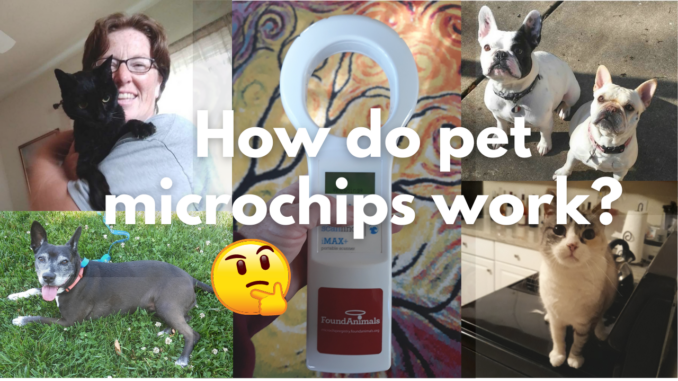
Are microchips GPS? Do they need to be registered? Will they cause cancer? Learn the answers to these questions and more!
Why microchip?
When microchips came out in the 1990’s, we in animal welfare thought they were the Holy Grail. Never again would a pet get lost! Here we are 25 years later and sadly it didn’t work out that way, but not through any fault of the product itself. Rather, their lack of universal and proper use. Read on…
The microchip provides a lifetime ID for your pet. Once implanted and registered, the information is there forever. It can’t be undone or “un-registered” although many people believe this will happen if they don’t pay for the yearly premium membership offered by some registries.

Today’s chips and scanners are universal, meaning that any vet or shelter in the U.S. Europe, Australia … should be able to scan and read any chip in a found pet. So it doesn’t matter which brand of chip you buy so long as it is properly registered.
A microchip ID is cheap insurance for the protection of your animal family members. Millions of stray dogs and cats end up in animal shelters every year, and too many are never found and reclaimed because the shelter has no way of identifying the owner.
You may think you don’t need a chip because your pet wears a collar with an engraved ID tag or QR code tag. That’s great, and of course highly recommended, but it’s not foolproof. Collars can fall off, tags can wear out and be illegible, and license tags require someone at the other end of the phone line to check the tag number and give out owner info. The collar and tag are low-tech and highly effective in keeping pets at home, but the microchip is a guaranteed backup.
Where to purchase a microchip
Most often, microchips will be purchased at a vet hospital. Prices vary widely depending on the area and the cost of doing business, with an approximate range of $45-80. This price includes implantation, as it’s not usual for vets to sell chips to the pet owner to implant at home. This may be the most convenient way to go about it, as you can even have this done while you’re in with your pet for a checkup or some other procedure.
A cheaper route, if it’s available in your area, is to microchip your pet at a mobile clinic. These clinics are usually held at feed stores or pet shops, and they offer basic services like vaccinations and deworming. The price may be as low as $15, or even included with a combo package of other services for a new dog or cat.
In the U.S., at least in California and most other states, microchipping is not considered a medical procedure and as such can be done by anyone. This is a big help to shelters, rescue groups, and breeders, who do their own microchipping in-house without having to pay a veterinarian. This ensures that any animal leaving their care and custody has permanent ID.
Most microchip manufacturers sell in large batches to vets, shelters, and other businesses. A few, however, will sell in smaller quantities of 1-5 chips. This is helpful for the pet owner who wants to implant their own chips at home without having to go to a veterinarian or other service provider. There are many different manufacturers to choose from, so if you decide to go this route you can shop around for the best deal.
Implanting the microchip
Most people have their pets chipped at the vet. An ideal time for this is during spay/neuter surgery when the animal is anesthetized. You might even get a discount since you are having other services performed the same day.
Animal shelters typically chip animals adopted from their facility, and many offer microchipping to outside animals, especially if they have a spay/neuter clinic. Check the websites of your local shelters to see if they provide this service.

As mentioned, in the U.S. it is legal for anyone to implant a chip, but it should be done by someone who knows what they are doing. You want to make sure the chip is implanted securely and properly and that the animal is caused minimal pain and stress during the procedure.
There is a lot that can go wrong during chip implantation. If not done correctly, the chip can fall right out when the needle is removed. The animal can be injured or at the very least caused pain if the needle is stuck into the wrong part of the body. The chip is meant to be placed in a pocket under the skin, not in any muscle or other tissue. If the needle isn’t handled in a sanitary manner, the implantation site can become infected. This is rare, but it can happen. Don’t let these possible complications deter you from having your pet chipped, but rather make sure you have it done by someone experienced and competent.
Registering the microchip
If you forget everything else you learned about pet microchips, remember this: MICROCHIPS MUST BE REGISTERED! Misunderstanding of this process is the downfall of the system.
As many as 50% of chipped pets entering shelters do not have correct registration info. Either the chip is not registered at all, it is registered to a former owner who doesn’t remember who they gave their pet to, or it is registered to the current owner but with disconnected phone numbers and other out-of-date contact info. In these cases, the owner may be at home waiting for a phone call because “my pet is chipped” but that call will never come.
It is your responsibility to register your pet’s microchip. I can’t tell you how many people I have talked to who insist that they don’t need to do this because their veterinarian has the information. Here’s a newsflash: veterinarians do not register microchips for you, and many do not even keep the chip number in the pet’s file. Some shelters will register the chip for you at the time of adoption, but just as many will not. You cannot rely on anyone else to complete this crucial process for you.
Most often you will register the chip with the manufacturer, but there are many other registries to choose from. Check out my article and video to determine which is the best pet microchip registry for you. Whichever you choose, do not delay in registering. Do it as soon as you get home from the vet or wherever you had the chip implanted. One of the easiest registries to use is Free Pet Chip Registry. You can complete the process online in less than 10 minutes.
Keep records of your pets’ chip numbers. If your pet goes missing, you will want to call the registry right away to make sure the information is correct and to report him or her lost. If you move, change a phone number, or rehome your pet, you will want to make sure the information is updated. In a recent case in East Bay California, a Frenchie was reunited with his family three years after going missing thanks to the microchip!
I keep a spreadsheet of my pets’ microchip numbers in my computer. You can store your numbers in your phone, tablet, or on paper. For extra security, you can upload the information to a cloud like Google Drive or Dropbox. That way, if you lose the physical files, such as in a fire, you can still access them online.
Are microchips GPS?
This is a question that gets asked A LOT. We all wish it were so, but the answer is no, pet microchips do not have GPS capability. The reason is that GPS requires an energy source like a battery which must be recharged. Since the microchip is inside the pet’s body, there is no way to connect it with an external power source.
As discussed in Using technology to find a lost pet, GPS collars and tags are another option for identification. They can be effective in quickly locating a lost pet, but they must be recharged regularly and are not a permanent, lifetime form of ID like the microchip.
Pet microchip myths
There are no shortage of myths and misunderstandings about pet microchips. These have the unfortunate result of discouraging folks from getting their pets chipped.
Myth #1: Microchips cause cancer
This is one of the most prevalent and damaging myths, and it has no basis in fact. The studies that purport to prove that microchips cause cancer were conducted on labratory mice and rats. If you’ve ever had mice and rats as pets, which I have — they make great companions, especially rats — you will know that THEY ALL GET CANCER.
They have sadly short lifespans, 2-3 years at most, and if they live into old age they will develop cancer. To say that the microchip caused the cancer is ridiculous. Tell that to the millions of microchipped pets who live long, healthy, cancer-free lives.
Myth #2: Indoor pets don’t need a microchip
When I worked in animal sheltering, I took lost reports every day from folks who lost an indoor pet. Over and over I’d ask, “Is s/he microchipped?” and they would respond, “No, s/he’s indoors only.” Yet here we are, at the shelter filling out the lost report.

When a pet goes missing, it’s an accident. We don’t intend for it to happen, but it does, for any number of reasons. The microchip is like insurance. You pay your car insurance every month even though you don’t have an accident, so if you do, it’s there for you when you need it. Buying it after the accident won’t help.
Myth #3: The chip doesn’t need to be registered
I’ll bring this up again because it is so important. I can’t tell you how many people have stated that they didn’t register the chip because “my vet has my information.” As mentioned, vets usually don’t keep your chip information on file and they dont register for you. I wish they would, but in fairness it isn’t their responsibility.
Register your pet’s microchip today. Don’t wait another minute.
Myth #4: Use a stud finder to locate a microchip
Here’s a real head-scratcher I thought I’d include to illustrate the absurdity of the many myths people believe, and of some of the nonsense that is on the internet. When I was starting my channel, I searched on YouTube to see what content was out there in my area of expertise and what was lacking. Along with psychics, “the secret,” and magic spells to bring home a lost pet, I found a video on using a stud finder to locate a microchip in a pet.
First, this is bunk. A stud finder measures changes in density in walls. It doesn’t read radio frequencies, which is what a microchip contains. Second, the stud finder won’t show the number, so whats the point? If you find a stray dog or cat and decide to house them and look for the owner instead of taking them to a shelter, you should always have them properly scanned for a microchip.
I hope this information has helped you to understand how pet microchips work and how to use them to keep your pets safe.




